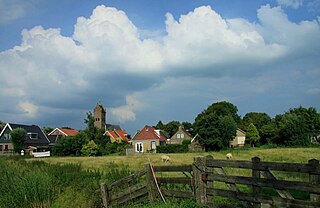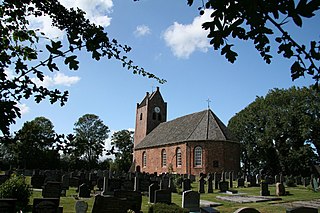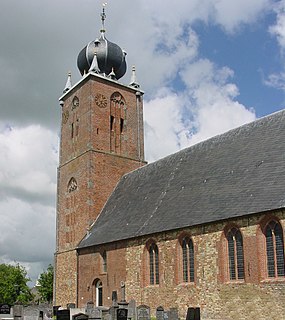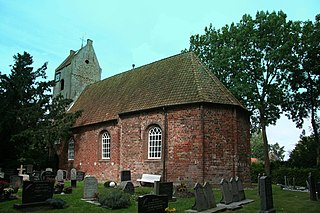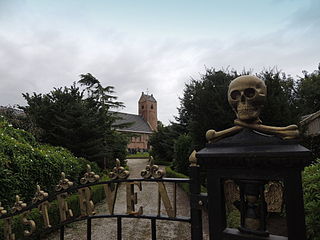| Protestant church of Swichum Saint Nicholas church | |
|---|---|
 Church of Swichum | |
| History | |
| Dedication | Before the Reformation, to Saint Nicholas |
| Specifications | |
| Materials | Brick |
The Protestant church of Swichum or Saint Nicholas Church [1] is a religious building in Swichum, Netherlands, one of the many medieval churches in Friesland.

Swichum is a village in Leeuwarden municipality in the province of Friesland, the Netherlands. It had a population of around 50 in January 2017.

The Netherlands, also called Holland, is a country located in Northwestern Europe with some overseas territories in the Caribbean. In Europe, it consists of 12 provinces that border Germany to the east, Belgium to the south, and the North Sea to the northwest, with maritime borders in the North Sea with those countries and the United Kingdom. Together with three island territories in the Caribbean Sea—Bonaire, Sint Eustatius and Saba—it forms a constituent country of the Kingdom of the Netherlands. The official language is Dutch, but a secondary official language in the province of Friesland is West Frisian.

Friesland, historically known as Frisia, is a province of the Netherlands located in the northern part of the country. It is situated west of Groningen, northwest of Drenthe and Overijssel, north of Flevoland, northeast of North Holland, and south of the Wadden Sea. In 2019, the province had a population of 647,672 and a total area of 5,749 km2 (2,220 sq mi).
The nave was built in the 13th century and the semicircular choir dates from the late 13th century; both are built out of red brick. [1] The tower was built in the 14th century and the furniture in the church dates from the 19th century. [1]

The nave is the central part of a church, stretching from the main entrance or rear wall, to the transepts, or in a church without transepts, to the chancel. When a church contains side aisles, as in a basilica-type building, the strict definition of the term "nave" is restricted to the central aisle. In a broader, more colloquial sense, the nave includes all areas available for the lay worshippers, including the side-aisles and transepts. Either way, the nave is distinct from the area reserved for the choir and clergy.
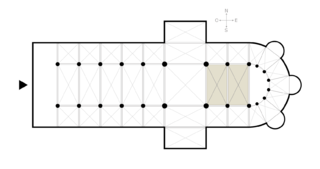
A choir, also sometimes called quire, is the area of a church or cathedral that provides seating for the clergy and church choir. It is in the western part of the chancel, between the nave and the sanctuary, which houses the altar and Church tabernacle. In larger medieval churches it contained choir-stalls, seating aligned with the side of the church, so at right-angles to the seating for the congregation in the nave. Smaller medieval churches may not have a choir in the architectural sense at all, and they are often lacking in churches built by all denominations after the Protestant Reformation, though the Gothic Revival revived them as a distinct feature.

A brick is building material used to make walls, pavements and other elements in masonry construction. Traditionally, the term brick referred to a unit composed of clay, but it is now used to denote rectangular units made of clay-bearing soil, sand, and lime, or concrete materials. Bricks can be joined together using mortar, adhesives or by interlocking them. Bricks are produced in numerous classes, types, materials, and sizes which vary with region and time period, and are produced in bulk quantities. Two basic categories of bricks are fired and non-fired bricks.
The building is located on the Ayttadyk 3 [2] and was once a Roman Catholic church dedicated to Saint Nicholas but became a Protestant church after the Protestant reformation. It is listed as a Rijksmonument, number 24519, and is rated with a very high historical value [3] and is in the care of Stichting Alde Fryske Tsjerken (Old Frisian Churches Foundation). [4]

Saint Nicholas of Myra, also known as Nicholas of Bari, was an early Christian bishop of the ancient Greek maritime city of Myra in Asia Minor during the time of the Roman Empire. Because of the many miracles attributed to his intercession, he is also known as Nicholas the Wonderworker. Saint Nicholas is the patron saint of sailors, merchants, archers, repentant thieves, children, brewers, pawnbrokers, and students in various cities and countries around Europe. His reputation evolved among the faithful, as was common for early Christian saints, and his legendary habit of secret gift-giving gave rise to the traditional model of Santa Claus through Sinterklaas.

A rijksmonument is a national heritage site of the Netherlands, listed by the agency Rijksdienst voor het Cultureel Erfgoed (RCE) acting for the Dutch Ministry of Education, Culture and Science.
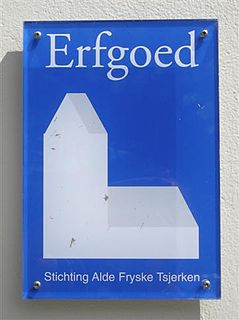
Stichting Alde Fryske Tsjerken is a foundation which aims to preserve church buildings in Friesland, the Netherlands.



